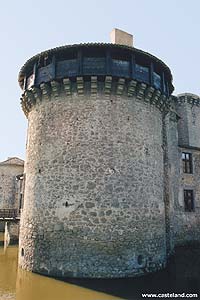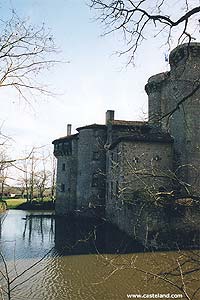

Charente Maritime |
Deux Sèvres |
Vienne |
Other regions & other castles |
Previous months’ selections |
| Tennessus Castle |
|
|
At the time of the siege of Parthenay by the Dauphin's army in 1419, the Château belonged to Guillaume de la Court, one of the rebels against royal authority. On the orders of the Duke of Vertus, a detachment was sent to capture and destroy Tennessus; but the castle held out for as long as that of Parthenay, and was still resisting at the time of Parthenay's surrender on 31 August. By 1486, the Château belonged to Catherine de Luxembourg, wife of the constable de Richemont; later the property had passed to a local squire, Regnault de Grany. By the start of the 16th century, Tennessus was in the hands of the Bodet de la Fenêtre family. Its fortifications offered too valuable a means of resistance for it not to become embroiled in the Wars of Religion. A party of Catholics quartered themselves here in 1590 and established links with the Catholics of Poitiers. It is not clear how long they stayed, but they must have represented a considerable thorn in the side of the Governor of Poitou, Malicorne, who had set up his headquarters in nearby Parthenay. In all likelihood, Malicorne would have dislodged them from Tennessus only in January 1591, at the same time as he expelled others from the Château at Saint-Loup.
The new lords remained in Tennessus until the Revolution, with their last descendants emigrating to Canada in 1792. Their steward, Jean Voyer, who lived at Tennessus, was sentenced to be deported for the part he played in a murder at Amailloux. The Château itself was also condemned to demolition, by a decree of the director of Deux-Sèvres issued on 25 March 1793. But this important monument, so often threatened in the course of its embattled existence, fortunately escaped the new danger: the orders of the decree were never executed. After a number of changes of ownership during the 19th and early-20th centuries, the Château again seemed destined for ruin, this time through neglect. But in 1975 it was bought by the sculptor, Dominique Piéchaud, who undertook a number of urgent works of salvage and restoration. In 1989, Tennessus was sold again, finally falling into the hands of the English! The new owners, Nicholas and Philippa Freeland have continued the major restoration programme; and have, most recently, restored the top floor of the keep to create a magnificent new bed & breakfast room: the Sentinel's Chamber. Text extracted the site www.tennessus.com |
|
Castle of the month : |
Search |
For any question concerning this Web site, send a message to webmaster

 No
one knows who built the original keep at Tennessus. The first known
mention of the "tower, fortress, lodging, and village of Tennessus"
is in a document dating from 1404, when it was owned, in his wife's
name, by Challot des Près, lord of Fontenioux-Rolland.
No
one knows who built the original keep at Tennessus. The first known
mention of the "tower, fortress, lodging, and village of Tennessus"
is in a document dating from 1404, when it was owned, in his wife's
name, by Challot des Près, lord of Fontenioux-Rolland. A
praesidial decree from Poitiers, dated 12 March 1607, ordered that
the Château should be sold in order to pay François
Mothais, the trustee (and uncle) of François Bodet; it thus
passed into the hands of a branch of the famous Chasteignier family
(whose coat-of-arms may be found on the entrance arch).
A
praesidial decree from Poitiers, dated 12 March 1607, ordered that
the Château should be sold in order to pay François
Mothais, the trustee (and uncle) of François Bodet; it thus
passed into the hands of a branch of the famous Chasteignier family
(whose coat-of-arms may be found on the entrance arch). 
